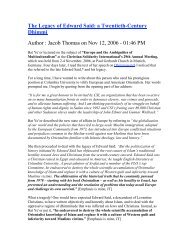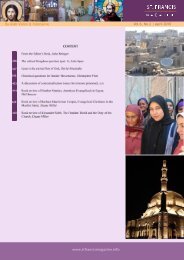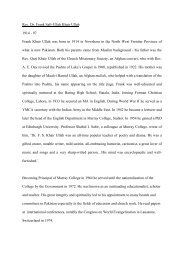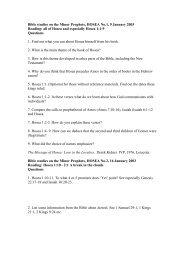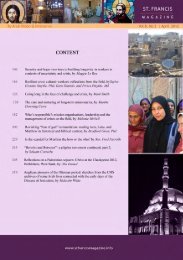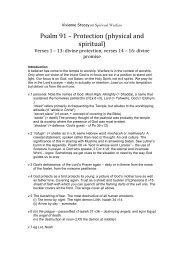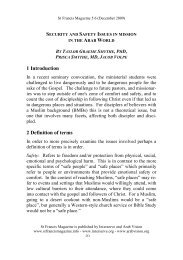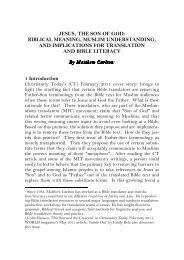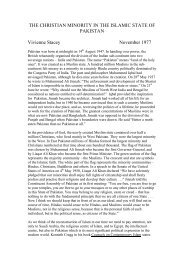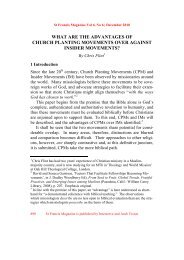download the pdf - St.Francis Magazine
download the pdf - St.Francis Magazine
download the pdf - St.Francis Magazine
Create successful ePaper yourself
Turn your PDF publications into a flip-book with our unique Google optimized e-Paper software.
<strong>St</strong> <strong>Francis</strong> <strong>Magazine</strong> Vol 8, No 4 | August 2012<br />
would contradict <strong>the</strong> ideological character of <strong>the</strong> Islamic Republic.”<br />
(Afshari 2001, 16) The result is, “The regime has codified <strong>the</strong> primordial<br />
societal prejudices into <strong>the</strong> state’s legal system.” (Afshari<br />
2001, 290) The Islamic regime of Iran has tapped into longstanding<br />
prejudice found within Islam that categorizes Self/O<strong>the</strong>r<br />
through identifications like najes, which define o<strong>the</strong>rs as emitting<br />
ritual and physical impurity. Both <strong>the</strong> secularization of Iranian society<br />
and <strong>the</strong> manipulation of religious symbols are key factors influencing<br />
<strong>the</strong> worldview of <strong>the</strong> modern Iranian.<br />
6 History of Post Khomeini Iran<br />
The history of post-Khomeini Iran is an important part of Iranian<br />
history. This history is <strong>the</strong> context which shapes <strong>the</strong> background<br />
of Iranians who make up <strong>the</strong> church in <strong>the</strong> diaspora. Understanding<br />
this context will inform this research as I seek to uncover sources<br />
that fur<strong>the</strong>r entrench survival behavior into <strong>the</strong> general populace in<br />
Iran. On January 16, 1979, <strong>the</strong> Shah fled Iran. On February 1,<br />
1979, Ayatollah Khomeini landed on <strong>the</strong> tarmac of Mehrabad Airport<br />
in Tehran. The twenty-second of Bahman on <strong>the</strong> Iranian calendar<br />
(February 12, 1979) is celebrated as <strong>the</strong> day <strong>the</strong> revolution<br />
was “victorious”. It is deeply marked in <strong>the</strong> psyche of Iranians.<br />
Ebadi describes that day,<br />
That day, a feeling of pride washed over me that in hindsight makes me<br />
laugh. I felt that I too had won, alongside this victorious revolution. It<br />
took scarcely a month for me to realize that, in fact, I had willingly and<br />
enthusiastically participated in my own demise. I was a woman, and<br />
this revolution’s victory demanded my defeat (Ebadi 2007, 38).<br />
The French Islamic scholar Maxime Rodinson was <strong>the</strong> first to<br />
describe <strong>the</strong> Khomeinist regime as fascist. The acclaimed Iranian<br />
journalist Taheri describes twelve characteristics of generic fascism<br />
and applies <strong>the</strong>m to <strong>the</strong> Khomeini regime:<br />
1. Total control. The Khomeini totalitarian form of government<br />
seeks to control all aspects of individual and community<br />
life. He considers this control to extend to <strong>the</strong> past as<br />
well as <strong>the</strong> present and <strong>the</strong> future, accusing <strong>the</strong> government<br />
<strong>St</strong> <strong>Francis</strong> <strong>Magazine</strong> is a publication of Interserve and Arab Vision 408


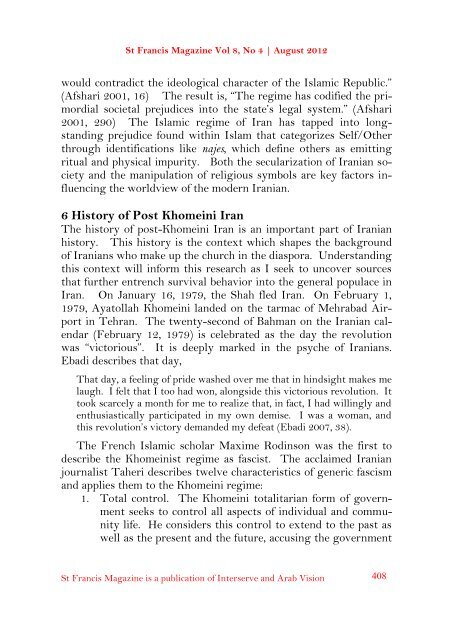

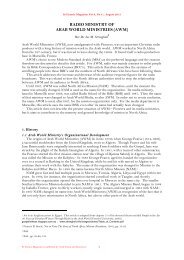
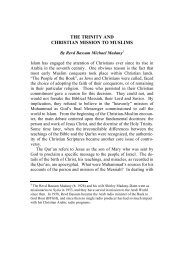
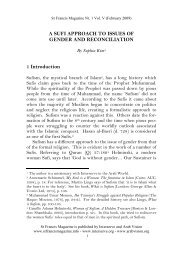
![Reflections on Surah Fatiha and the Lord's Prayer[1] - St.Francis ...](https://img.yumpu.com/49377951/1/184x260/reflections-on-surah-fatiha-and-the-lords-prayer1-stfrancis-.jpg?quality=85)
